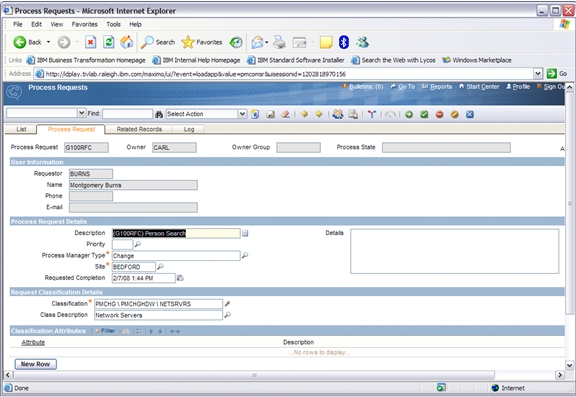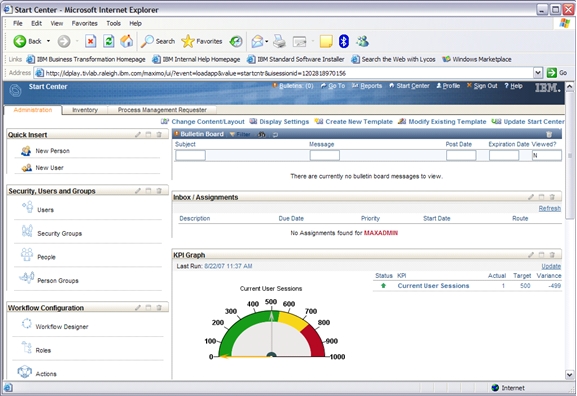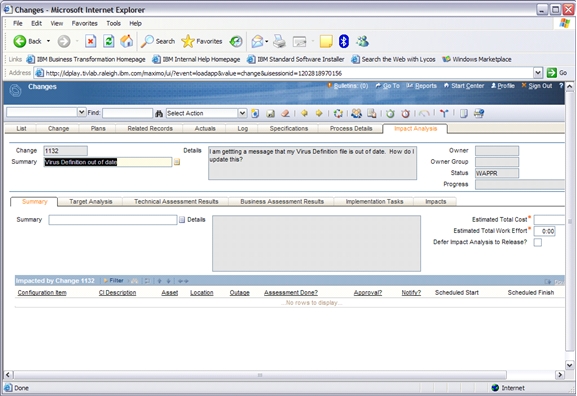Context
Tool mentors explain how a tool can perform tasks, which are part of ITUP processes and activities. The tasks are listed as Related Elements in the Relationships section.
You can see the details of how processes and activities are supported by this tool mentor, by clicking the links next to the icons:
Details
IBM® Tivoli® Change and Configuration Management Database (CCMDB) is an integrated management platform with a database to
manage, audit, and coordinate the Change Management and Configuration Management processes with user interfaces and
workflows designed to facilitate cross-silo cooperation in implementing these processes. With CCMDB, users can create
RFCs against target CIs and manage the lifecycle of the change to completion. Tasks and workflows can be customized for
each activity step in the process based on CI type and RFC type and can be assigned to one or more roles within the
organization for completion. The following is a description of how the steps in the process are executed using the
tool.
-
Create a Request for Change (RFC)
Any authorized CCMDB user can create a request for change (RFC) by providing a basic set of information. This
request could potentially come from the business or from a subject matter expert within IT.

Figure 1: Request For Change Creation Page
-
Accept and Categorize Change
Typically, a change owner will receive the RFC in the inbox in the Start Center for acceptance and
classification or rejection. When accepted, the RFC becomes a change. The change is classified, an appropriate
job plan is applied to the change, and some additional details may be added for the next individual in the
process, the change assessment and approval teams.

Figure 2: Changes
-
Assess Change
Next, information from the CCMDB is used to analyze the RFC to determine its impact on target CIs as well as
other impacted CIs, from both an IT and a business perspective. The impact on resources to build and deploy the
change is also assessed. With CCMDB, administrators can create specific tasks for individuals within the
organization to assess the potential impact of implementing the change. These tasks can be performed serially
or in parallel as well has have dependencies on previous tasks. For example, deploying an application upgrade
may require assessment tasks assigned to network specialists, storage specialists, application specialists and
others, while minor patch upgrades may only require assessments by application or OS specialists. The Changes
application provides an Impact Analysis tab that enables the user to identify the implementation tasks required
to carry out the change, along with their duration and costs.

Figure 3: Request For Change Creation Page
At this point, products such as Tivoli Business Systems Manager can also be utilized to help assess the impact
of the proposed change. Refer to the toolmentor: How to Use Tivoli Business Systems Manager to Assess the Impact of a Change
for details.
-
Approve and Schedule Change
After the assessments are completed and documented, the change goes through an approval and scheduling process.
Approvals may be routed to specific line managers or a Change Advisory Board, or CAB (via the Change Manager).
This step is also where the schedules of all pending changes are evaluated and planned. Because CCMDB
coordinates and captures the relevant assessment activities and results, the CAB members can quickly review the
potential impacts, schedules, rollback plans, etc.
-
Coordinate Implementation
When it is approved, the Change Owner will coordinate the implementation of the change, based on the
implementation tasks identified during the assessment phase.. Depending on the scope of the change, an
implementation build plan will be undertaken by the specific change assignee or for more complex changes, the
change might be handed off to Release Management process. In either case, the change can be built, planned, and
deployed utilizing Tivoli products such IBM Tivoli Configuration Manager and IBM Tivoli Provisioning Manager. Refer to the following tool mentors to understand how to build, plan, and deploy a release:
-
Review and Close Change
After the change is complete, a review takes place to determine whether the Implementation Plan, or the
Back-out Plan, or both worked correctly, and whether the Change was implemented on time and to cost. When these
items are verified, the appropriate CIs are updated. A timely scan of the component, application or the
environment can be used to verify completion and that the database should be updated.
For More Information
For more information about this tool, click on the link for this tool at the top of this page.
1 - ITIL® V3 Glossary
|



